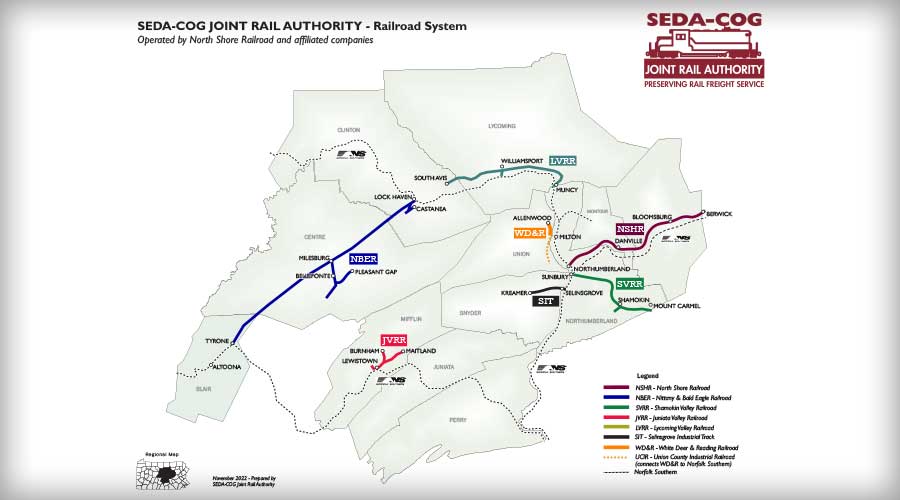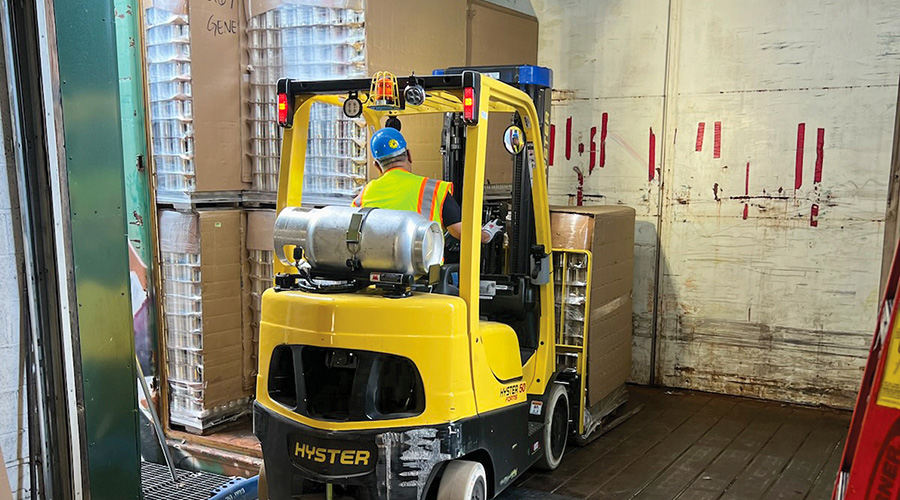Pennsylvania rail authority marks 40 years as a short-line preserver
7/10/2023
By Jeff Stagl, Managing Editor
The SEDA-COG Joint Rail Authority (JRA) marked a significant milestone on June 28. The organization that has worked to preserve branch lines and rail service in central Pennsylvania since the early 1980s reached its 40th anniversary.
The JRA was formed on June 28, 1983, through the SEDA Council of Governments Board of Directors to gain public ownership of rail lines that Conrail sought to abandon. The goal: to preserve rail service on the trackage and save the 3,000 jobs associated with the impacted industries.
The JRA initially was a seven-county municipal authority that worked to preserve service to rail-dependent industries through short-line operations. Centre, Clinton, Columbia, Lycoming, Montour, Northumberland and Union were the first participating counties.
The JRA held its first board meeting on July 6, 1983, and completed the purchase of 82 miles of Conrail’s lines on July 27, 1984. Those lines served 22 industries.
Now through its private-public partnership with North Shore Railroad Co. involving six short lines, the JRA serves more than 100 customers and registers more than 21,000 carloads annually. The authority owns more than 200 miles of rail lines in nine counties: Centre, Clinton, Columbia, Lycoming, Mifflin, Montour, Northumberland, Snyder and Union.
The lines are operated by North Shore’s Juniata Valley, Nittany and Bald Eagle, Lycoming Valley, North Shore and Shamokin Valley railroads. Portions of track used by North Shore’s Union County Industrial Railroad are owned by the JRA as well as private parties.
 In mid-1984, North Shore Railroad operated the first train on the JRA’s newly purchased lines. The authority acquired the trackage from Conrail. SEDA-COG Joint Rail Authority
In mid-1984, North Shore Railroad operated the first train on the JRA’s newly purchased lines. The authority acquired the trackage from Conrail. SEDA-COG Joint Rail AuthorityIn 2024, North Shore — which operates slightly more than 256 miles of track in central Pennsylvania — will mark its own 40th anniversary while the JRA will commemorate 40 years since it launched rail operations with North Shore. But for now, the authority is looking back at its accomplishments over the past four decades.
“We took beat up railroads and fixed them up to make them viable railroads again. The counties and industries were at risk of losing rail when Conrail pulled out,” says JRA Executive Director Steven Beattie. “It’s all about preserving freight rail in central Pennsylvania. We do it every day.”
That objective is underscored in the JRA’s mission statement: “To preserve and foster rail service in central Pennsylvania and to further economic development through retention, improvement and expansion of the infrastructure and the rail service it supports.”
The authority’s original thought process — which focused on preservation and growth — has permeated throughout its history, says Beattie.
“And it’s still the way we think,” he says.
Some of the authority’s seminal moments over the past 40 years include:
• the Shamokin Valley Railroad launching operations in 1988;
• acquiring lines in Lewistown and Williamsport from Conrail in 1996;
• the Juniata Valley and Lycoming Valley railroads launching operations in 1996;
• completing a new engine house in Williamsport at Newberry Yard in 1998;
• opening an engine house in Lewistown in 2003;
• handling the first traffic from the Marcellus Shale in 2008;
• completing a transload facility in Newberry in 2009;
• starting a major trackwork project funded by the federal Transportation Investment Generating Economic Recovery II program in 2011;
• acquiring 19.5 acres in Mifflin County in 2014 for future industrial development;
• purchasing lines in Snyder County serving Kreamer, Selinsgrove and Shamokin Dam from Norfolk Southern Railway in 2022; and
• the retirement of longtime Executive Director Jeff Stover — who led the JRA for 37 years — and installation of Steven Beattie as his successor in 2023.
 The JRA now owns more than 200 miles of track in nine central Pennsylvania counties. The authority serves more than 100 customers and logs more than 21,000 carloads annually. SEDA-COG Joint Rail Authority
The JRA now owns more than 200 miles of track in nine central Pennsylvania counties. The authority serves more than 100 customers and logs more than 21,000 carloads annually. SEDA-COG Joint Rail Authority A feed mill wouldn’t exist today if NS had abandoned the Snyder County track last year and the JRA hadn’t taken over the lines, says Beattie. NS had operated the lines since 1999 after purchasing them from Conrail. North Shore Railroad began operating the routes last year.
The JRA can’t replicate what a Class I can offer, but it can exploit its uniqueness as a public entity that owns a lot of track and offers rail services, says Beattie.
“We know the ground we live on,” he says. “We are always looking to expand and bring value.”
The JRA also has matured as an organization over the years.
“We started with handshake deals, but have gotten a lot more sophisticated. There have been improvements from lessons learned,” says Beattie. “We understand we’re more accountable to the public.”
Looking back, the JRA long has had a positive impact on the local economy by fostering job creation, attracting new industries and supporting the growth of businesses in the region. By providing reliable and cost-effective rail service, the authority has helped reduce congestion on roads, lower carbon emissions and enhance supply-chain efficiency, JRA leaders believe.
Over the years, the authority has tried to build strong partnerships with local businesses, industries and agricultural producers. Its short-line operators have facilitated the movement of various goods, including raw materials, agricultural products and finished goods. Traffic volumes have steadily increased, says Beattie.
 In the early 1980s, Conrail sought to abandon 82 miles of track in central Pennsylvania, but the JRA stepped in to buy the lines and preserve rail service. SEDA-COG Joint Rail Authority
In the early 1980s, Conrail sought to abandon 82 miles of track in central Pennsylvania, but the JRA stepped in to buy the lines and preserve rail service. SEDA-COG Joint Rail Authority Now, the JRA aims to continue building traffic in part by ensuring its rail lines are in working order. The authority is working on a new long-range capital improvement plan that will address needed infrastructure improvements over the next five to seven years. Some work might start in 2024.
“We haven’t done a long-range plan like this in 10 years,” says Beattie. “We did what we could at the start since the railroads were neglected for years. It’s time for more capacity improvements.”


